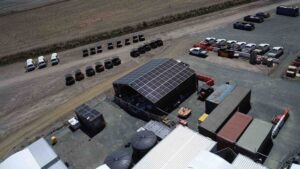A US start-up whose “earth-mount” solar system claims to costs less than 50c (US) per watt to install, take half the time and use one-third of the land, has raised more than $US17 million from investors, including a heavy hitting renewables tech-focused venture capital fund.
Arizona-based Erthos, which was founded in 2019, said on Tuesday that it had closed a $US17.5 million Series B financing round, led by Capricorn Investment Group’s Technology Impact Fund, which is known for backing iconic cleantech companies like Tesla.
The second funding round builds on the $7.4 million the company raised in 2019, which helped finalise the development of its trademarked Earth Mount Solar PV solution, launch its autonomous cleaning robot, and secure its first portfolio of projects.
Just as the company’s name suggests, Erthos’ approach to solar takes the view that, the most economical way to produce solar energy is to simply put the PV modules on the ground.
The upsides to this are various, including: no sub-surface risk; 70% less cable; 70% less trenching; 70% less water use; hurricane proof, and; low visual disturbance. All of this adds up to less labour and materials and, therefore, less cost and time.
The main down-side is the that the panels, being installed directly on the earth, get pretty dirty. But for that problem, Erthos has developed an autonomous cleaning robot that sweeps the solar array each night and captures module-level DC health data.
As for the losses in efficiency from having panels lying flat, instead of angled for optimum insolation, Erthos argues that between the low-cost of panels and the money saved on automated tracking systems and steel and other construction materials, these losses are easily accounted for.
The company’s new backers at Capricorn appear to agree.
“We see in Erthos a unique opportunity where simplicity and speed to market is coupled with an enormous ability to effect change,” said Ion Yadigaroglu, partner at Capricorn.
“Additionally, declining module prices, increasing steel prices, and rampant supply chain problems are creating enormous tailwinds for Erthos.”
Erthos CEO Jim Tyler, who was previously the vice president of engineering, procurement and Construction at First Solar, said the new funds would be used to execute phase two of the company’s market rollout, including progressing a pipeline of more than 2.5GW of projects.
“With experience in solar technologies, solar development, artificial intelligence, and autonomous devices, Capricorn brings strategic advantages,” he said. “We are excited to have Capricorn in the Erthos family and look forward to this next phase of execution.”
The push to lower and lower cost large-scale solar is building momentum around the globe, as countries scramble to meet increasingly ambitious emissions reduction and renewable energy targets.
In Australia, the federal government late last year set a “solar stretch target” of achieving ultra low cost solar generation at $15 per megawatt hour, which is roughly a third of today’s cost.
Working with ARENA, this has since morphed into a national “Solar 30 30 30” target, to improve solar efficiency to 30 per cent and reduce the cost of solar to 30 cents a watt installed (utility-scale) by 2030.
To support this target, the Morrison government more recently announced up to $40 million in new funding, to be allocated via R&D funding rounds that will open to expressions of interest next month.
Leading the push in Australia, technology-wise, is Sydney-based company 5B, which has likewise attracted funds from big-hitting investors, as it works to ramp up production and efficiencies of its concertina-style Maverick solar solution, which can be deployed up to 10 times faster than conventional ground-mounted PV panels and claims to be able to generate up to twice the energy using the same amount of land as conventional solar.









